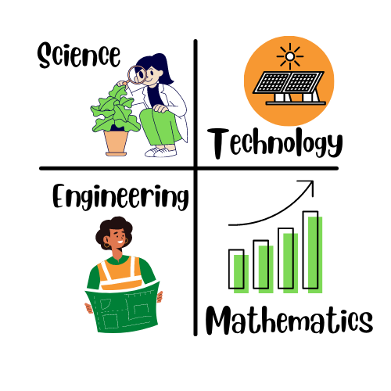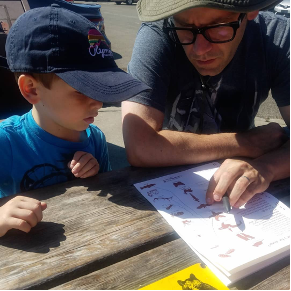STEM and the Guidelines


As someone whose career has focused on connecting people to the natural world, I always wonder what image comes to mind when I mention that I work at the STEM Research Center at Oregon State University. While the acronym stands for Science, Technology, Engineering, and Mathematics, the millions of dollars invested in STEM education (US Department of Education, n.d.) has never been about four discrete disciplinary silos (Seery et al., 2018). Environmental Education and STEM education are both educational approaches meant to create a society that is able to tackle global challenges. This requires inquiry, design-based thinking, and like anything else with science, failure too. It’s a process (Seery et al., 2018).
So how can we link STEM and EE? There are several resources available to help you apply a STEM approach to your Environmental Education program or event. A starting point is a familiarity with the Next Generation Science Standards and the eight practices of Science and Engineering (https://www.nextgenscience.org):
- Asking questions and defining problems
- Developing and using models
- Planning and carrying out investigations
- Analyzing and interpreting data
- Using mathematics and computational thinking
- Constructing explanations and designing solutions
- Engaging in argument from evidence
- Obtaining, evaluating, and communicating information
NAAEE also has great resources to guide you. Using the Guidelines for Excellence will support you in your STEM approach. In fact, you will find many similarities in Strand 1 of the K-12 Environmental Education guide (p.17) and the science & engineering practices above. The guides are an excellent (pun intended) resource to support high-quality programming and resource development. Materials and programming for EE and STEM should build lifelong learning skills that enable people to analyze, interpret, and communicate findings.
Regardless of the phenomena to explore, inclusiveness in programming and materials is a must. Key Characteristic #1 in the Environmental Education Materials guide (pg.19) focuses on making sure materials are accurate and inclusive. This often requires us to step outside of routines and allow flexibility so that the materials are building on knowledge people are bringing with them and making sure sources are accessible and relevant. Imagine going to the Grand Canyon to learn about the rainforest. It is important for materials to be relevant for the learners as well as relevant to the place. Including caregivers, when possible, is another great tool for fostering the skills and practices needed for

both EE and STEM (Pattison et al., 2016; Staus et al., 2020). Guideline 3.2 in the Early Childhood Environmental Education Programs guide (pg.28) points out the important role of adults in providing the context in order to scaffold learning opportunities.
Learning experiences both inside and outside of the classroom can be both fun and transformative for learners (Storksdieck & Falk, 2020). Using the Guidelines for Excellence will support you in developing quality materials, activities, or programs that are relevant, inclusive, and cross-disciplinary.
A few take-aways:
- Be a rebel! Don’t hold to disciplinary silos, instead remember that STEM should be a cross-disciplinary approach. Just as teaching a plant science class is not the same as environmental education, using math doesn’t make something STEM.
- Look outside of your subject or discipline to provide a holistic approach. This will provide more opportunities for people to relate and connect.
- When programming and materials are relevant, they are more likely to be accessible. Meet people’s interests and build from there.
Resources:
- IDEO Design Thinking
- The Engaging Young People in 21st Century Community Challenges: Linking Environmental Education with STEM report
- NSTA Science and Engineering Practices
- NEEF Greening Stem Hub
References:
Pattison, S., Svarovsky, G., Greenough Corrie, P., Benne, M., Nuñez, V., Dierking, L., Verbeke, M. (2016). Conceptualizing early childhood STEM interest development as a distributed system: A preliminary framework. National Association for Research in Science Teaching Annual Conference.
Seery, N., Gumaelius, L., and Pears, A. (2018) "Multidisciplinary teaching: The emergence of a holistic STEM teacher," 2018 IEEE Frontiers in Education Conference (FIE), pp. 1-6, doi: 10.1109/FIE.2018.8658552.
Storksdieck, M., and Falk, J. (2020). Valuing free-choice learning in national parks. Parks Stewardship Forum 36(2): 271–280. https://escholarship.org/uc/psf
US Department of Education (n.d.). Science, Technology, Engineering, and Math, including Computer Science. US Department of Education. https://www.ed.gov/stem

Comments
Thanks, Kelly for mentioning NEEF's Greening STEM Hub as a resource.